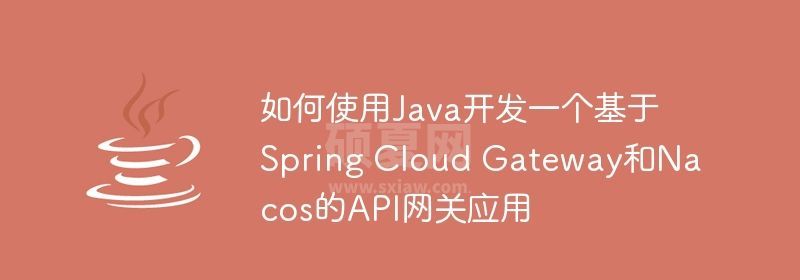如何使用Java开发一个基于Spring Cloud Gateway和Nacos的API网关应用

如何使用Java开发一个基于Spring Cloud Gateway和Nacos的API网关应用
随着微服务架构的广泛应用,API网关在系统架构中起着至关重要的作用。API网关作为微服务架构的入口,负责接收外部请求并将其转发到相应的微服务上。在本文中,我们将使用Java语言,并结合Spring Cloud Gateway和Nacos,来实现一个简单的API网关应用。
一、环境准备
在开始之前,我们需要准备一些环境:
- JDK:确保已安装Java开发环境。
- IDE:推荐使用IntelliJ IDEA或Eclipse等Java开发IDE。
- Maven:确保已安装Maven用于构建项目。
- Nacos:Nacos是一个动态服务发现、配置和服务管理平台。我们需要安装并运行Nacos服务。
二、创建项目
使用IDE打开一个新的项目,并创建以下几个类:
- APIGatewayApplication: 用于启动整个应用程序。
- APIGatewayConfig: 用于配置API网关。
- CustomGlobalFilter: 自定义全局过滤器。
- CustomPredicate: 自定义路由断言。
- RouteDefinition: 路由定义实体类。
- RoutesConfig: 用于配置路由信息。
导入相关依赖:
在pom.xml文件中添加以下依赖:
<!-- Spring Cloud Gateway --> <dependency> <groupId>org.springframework.cloud</groupId> <artifactId>spring-cloud-starter-gateway</artifactId> </dependency> <!-- Nacos Discovery --> <dependency> <groupId>org.springframework.cloud</groupId> <artifactId>spring-cloud-starter-alibaba-nacos-discovery</artifactId> </dependency>
三、配置API网关
- 在APIGatewayConfig类中,添加@EnableGateway注解以启用Spring Cloud Gateway。
配置Nacos服务发现:
@Bean public DiscoveryLocatorProperties nacosProperties() { DiscoveryLocatorProperties properties = new DiscoveryLocatorProperties(); properties.setEnabled(true); properties.setScheme("http"); properties.setHost("localhost"); properties.setPort(8848); properties.setPreferIpAddress(true); return properties; }
三、自定义全局过滤器
创建CustomGlobalFilter类,并实现GlobalFilter和Ordered接口:
@Component
public class CustomGlobalFilter implements GlobalFilter, Ordered {
@Override
public Mono<Void> filter(ServerWebExchange exchange, GatewayFilterChain chain) {
// 自定义过滤器逻辑
return chain.filter(exchange);
}
@Override
public int getOrder() {
// 过滤器执行顺序
return 0;
}
} 在自定义过滤器中,我们可以实现一些通用的逻辑,比如鉴权、日志记录等。
四、自定义路由断言
创建CustomPredicate类,并实现Predicate
@Component
public class CustomPredicate implements Predicate<ServerWebExchange> {
@Override
public boolean test(ServerWebExchange serverWebExchange) {
// 自定义路由断言规则
return true;
}
}在自定义路由断言中,我们可以实现自定义的路由匹配规则,比如根据请求头、请求参数等来进行路由判断。
五、配置路由信息
创建RouteDefinition类,用于定义路由规则:
public class RouteDefinition {
private String id;
private String path;
private String uri;
private List<String> predicates;
// 其他属性...
// getter和setter方法省略
}创建RoutesConfig类,并添加@Configuration注解:
@Configuration
public class RoutesConfig {
@Bean
public List<RouteDefinition> routes() {
List<RouteDefinition> routes = new ArrayList<>();
// 添加路由规则
RouteDefinition route1 = new RouteDefinition();
route1.setId("route1");
route1.setPath("/api/**");
route1.setUri("http://localhost:8081");
route1.setPredicates(Collections.singletonList("CustomPredicate"));
routes.add(route1);
return routes;
}
}在RoutesConfig类中,我们可以根据业务需求定义多个路由规则,并将其添加到routes中。
六、启动应用程序
在APIGatewayApplication类中,添加@SpringBootApplication注解,并在main方法中调用SpringApplication.run()方法来启动应用程序。
至此,我们已经完成了一个基于SpringCloud Gateway和Nacos的API网关应用的开发。通过使用SpringCloud Gateway,我们可以方便地实现API网关的功能,并且使用Nacos作为服务注册与发现的工具,进一步提升了系统的可伸缩性和灵活性。
本文只是一个简单的示例,实际应用场景中还可能涉及更复杂的路由规则、过滤器等。在实际开发中,我们还需要考虑异常处理、限流、重试等方面的问题。
参考文档:
- [Spring Cloud Gateway官方文档](https://docs.spring.io/spring-cloud-gateway/docs/current/reference/html/)
- [Nacos官方文档](https://nacos.io/zh-cn/docs/what-is-nacos.html)
以上就是如何使用Java开发一个基于Spring Cloud Gateway和Nacos的API网关应用的详细内容,更多请关注其它相关文章!
